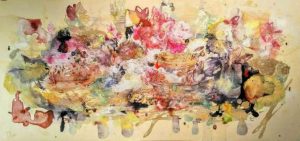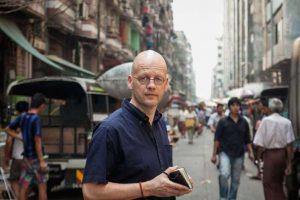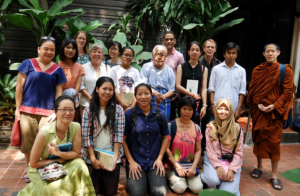Original Chinese text: Elsa Lam
Translation: Brenda Leung
English Editing: Raymond Lam
During the hot days of July and August, I took a trip to Turkey. Besides the handsome statue-like faces of the Turks, my impressions of Turkey are pretty much stored in terms of colors.
Some People Like Blue
The most popular colors in Turkey are red and blue.
The Turkish flag is bright red, and red is a dominant colour in Islam. It is said that in Turkey, more than 90 percent of the population is Muslim. We set off to Turkey by invitation of a Turkish NGO called Anatolia Cultural & Dialog Centre”. The purpose was to invite Buddhists in Hong Kong to a cultural exchange with the Muslims in Turkey. The trip was a marvellous success indeed.
As per the color blue, there is a blue in Turkey that is so renowned that it is even called “Turkish Blue”, indicating the Turkish people’s love of the color.
I would like to write about blue because Turkish Blue has totally changed my perception of blue. Blue has never been my favorite color. It is said that because blue became a national favourite in Turkey because it was reminiscent of water, a natural resource the country lacks. On this trip we actually visited the underground reservoir monuments and the arid rocky landforms. Also, because Turkey has a huge coastline and an open sky, the Turks constantly live in these beautiful shades of azure. It seems only natural that blue has become so popular. There is another rich blue stone called turquoise and it has been a prized treasure since ancient times. The Turkish specialty, the “Evil Eye”, represents blessings and it is also in blue, although it is more of a marine blue instead of a “Turkish Blue”.
The largest piece of blue is the sky. When walking in the historical sites of the ancient Greeks, I could deeply experience that under the bright blue sky in almost 40 degrees Celsius degree heat, one can hardly open one’s eyes in the blinding sunlight. The cloudless, sky blue of the heavens formed an almost chiaroscuro-like effect with the pure white marble, reflecting against our eyes and leaving us with the impression of an infinitely blinding world. This made it very difficult for our tour guide, Mr. Yelbay, and the volunteers. They were fasting throughout the month of Ramadan and thus could not eat or drink from sunrise to sunset every day.
Enduring thirst and wanting of physical strength, they had to take us everywhere and had the patience and vigor to explain things to us. Their tirelessness was based on their faith and the intention to give back to the world, to do good deeds. And what was more respectful was that they did not intend to accumulate merits for such deeds and in this way they are really good role models for Buddhist practitioners.
The ambience of blue and white was also present in Pamukkale, another place that we visited on the trip. Pamukkale has groundwater springs, and just the sight of them can make one feel cool. And as you stand in the clear spring water, that the heat and sweat does not seem so intolerable. You can also see the brigade square indigo lakes that resembles the Jiuzhaigou calcification landscape. It is so beautiful that it looks like a mirror. However, I cannot tell whether the lake is blue or green, as we Chinese people commonly confuse the word “light green” (青), with the concept or sight of blue. For example, “青花”(blue and white porcelain)、“青天”(clear skies) and“青金石” (lapis lazuli) all refer to light blue-coloured things while using the word light green, as if blue and green were indistinguishable.
The Hymn of Blue
My impression of Istanbul is all blue. This is an ideal place for a honeymoon or a leisurely vacation. Istanbul is probably the most open, convenient and developed city in the Islamic region. Along the Istanbul waterfront is the gash between Europe and Asia. And the soft breeze from the ocean and the beautiful azure sky and crystal-sapphire ocean really beings joy! This is even more enjoyable for people like me who are used to Victoria Harbor in Hong Kong! The Venice Alley and the Seine River in Paris are all mesmerizing; but the coastline of Istanbul is laden with history and today’s prosperity, which gives this Islamic city a colorful background.
This was just a quick trip and because of the language barrier, I could not appreciate the cultural life of Istanbul that is the essence of a cosmopolitan city. However, as far as I know there are literary works and movies using Istanbul as the theme and background and I am sure this is not without a reason. I would really hope to have the opportunity to wander around the streets, visit their galleries and cafes and have a glimpse of their contemporary charm. However, compared to the coffee in Italy and France, the Turkish coffee is in fact not as tasty.
My tribute to blue must also include the Sultan Ahmed Mosque, also known as the Blue Mosque. Her elegant and bright blue patterns surely have “gorgeous” redefined. It is hard to imagine such delicate craftsmanship. Every stroke of the painting of “Koranic scripture”, the Magi poetry and the patterns of flowers and grass must have been painted with a reverent heart. The meticulous Praise to Allah is like the thangkas painted by devoted Tibetan Lamas. However, because there were too many tourists, I was too distracted and could not quietly admire it but only took lots of photos to soak up the majesty. I seized the moment to devour its splendour.
However, it was in another mosque that I could truly feel the peace of an Islamic mosque. There was a teenage volunteer from Russia who explained the teachings of Islam and demonstrated to us the postures of worship. He is a PhD student in Hong Kong and his English is very good. As he is Muslim, and in response to the Gülen movement (see separate article), he volunteered to be our translator. According to him, each pattern of an onion design on the carpet is the worship space for a Muslim, so that the group worships will look very organized.
The ceiling of the mosque is like a Byzantine Church. There is also the symmetrical arrangement of the dome and the mosaic windows for natural light. There are no decorations other than small benches and some humble followers. These all make us Buddhists feel the simple and quiet religious atmosphere. Islam advocates kindness and courtesy, and yet because of political or doctrinal dissent, some have resorted to violence. This causes a great deal of misunderstanding all over the world, and much pain and death.
The Metaphor of the Rainbow
We visited a mosque made of wood and it was really memorable. Perhaps wood construction is especially appealing to the Chinese. The carpet of this old mosque was Turkish Blue, and it had dark brown wood components. It all looked really pleasant, and its long history imparted to us a uniquely serene feeling. As if stepping into the historical flow of time and space, we all naturally slowed down our pace of walking and lowered our voices, paid attention to each corner, and were mindful of each walking step. We finally found the ostrich egg suspended aloft. It turned out that in ancient times the egg was used to drive away insects and small animals. And now this egg has become an antique treasure.
When the tour guide explained how the carving on the wood fences in fact described the planetarium constellation, I was actually distracted by a string of prayer beads on the carpet. These prayer beads are not for “reservation” of seats, or for donations. They are just a kind of giving so that the next follower can come and use the prayer beads.
There are ninety-nine beads on the Islamic rosary because every time you pray you need to praise Allah’s name ninety-nine times. There are some shorter versions of prayer beads for convenience to be carried around and they are composed of thirty-three beads. So reading the beads three times will make ninety-nine times. Once Mr Yelbay was doing a morning session on a flight and he took out his rosary to praise Allah. Beside him I was using a one hundred and eight beads rosary to do my Buddhist practice. Although we were sitting next to each other, we were practicing different religious practices. However, we both wished all sentient beings happiness.
Once in the street, I was holding a blue Islamic rosary (imitation turquoise) that I had just purchased in a gift shop, and the local people asked me why I did that. I did not quite understand what they talked about and could just guess their meanings. I told them I used the beads to recite “Om Mani Padme Hum” and demonstrated casually. The local people immediately put their thumbs up and gave me their praises. That was really heartwarming and interesting.
I just thought of the double rainbow we saw on the road. We were driving on the highway and encountered thunderstorms. I could not help but be a bit worried. Soon the thunderstorms stopped and a rainbow appeared in the sky, and it was not just one but two. So we all asked to stop the car and everybody got out of the car and took pictures. As we were in the countryside, we could see the whole rainbow and yet it was a pity that there was no wide-angle lens that could capture this panorama. We watched this with joy, and we all said that this was a blessing from the Bodhisattvas’ happiness. I think that this good omen nafter the storms could also be interpreted that a strong faith in one religion can accommodate someone else’s religion. The first rainbow is like one’s own religion and the second is like the religion of others, and people of different religions can work together, shoulder to shoulder, to send blessings to the world. This is perhaps the meaning that the Bodhisattvas wish to convey through the rainbows?





















